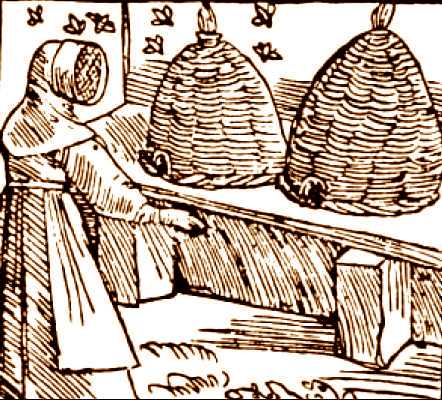What’s the Buzz on Bees?
By Sam Graham, Fairfax Master Gardener Intern

Skeps

Langstroth hive
Langstroth’s hives brought about a vast increase in beekeeping. As beekeeping in the 1800s increased, a deadly tracheal parasite began to impact beekeeping. The German Black Bees (Apis mellifera mellifera) kept at that time were highly vulnerable to these mites. For this reason, beekeepers in America began using the more resistant yellow Italian bees (Apis mellifera ligustica). This change was comprehensive, and German bees became all but extinct in the Americas over the next few decades.

German Black Bee (left) Italian Bee (right)
As the well-worn practices of family farming transitioned to the modern era of agriculture in the 1900s, pollination was outsourced, and the number of hives shrank as pollination services could now be trucked across state lines to align with crop maturity dates. All of this came at a cost. Beekeeping in Virginia decreased from approximately 100,000 hives in the early 1900s to around 8,500 hives in 2017. Interstate pollination helped spread invasive diseases that had previously been localized. Systemic pesticides drastically impacted colony health. Invasive mites and weather challenges wiped out the hives already weakened by these other factors.
As Master Gardeners, we want to play our part to protect this vital insect. The first step is to reduce or stop using pesticides. Growing a wide variety of flowering plants can contribute to optimal bee health. By having a selection of continuously flowering plants, gardeners can ensure forage for bees throughout the growing season. While flower gardens are nice, the reality is that bees collect nectar from 2 million flowers and fly 55,000 miles to produce a pound of honey. A healthy hive must create 60 pounds of honey to survive winter in Northern Virginia, which means it takes a lot of windowsill flower gardens to keep bees fed.
Trees are an alternative to flower gardens, and a major source of nutrition for pollinators. Trees that provide continuous benefit when planted together are Black Locust (Robinia pseudoacacia), American Plum (Prunus americana), Black Cherry (Prunus serotina), Persimmon (Diospyros virginiana) and Yellow Poplar (Liriodendron tulipifera). This five-tree combination provides major nectar and pollen sources for bees throughout the foraging season. Other great trees for pollinators include Black Tupelo (Nyssa sylvatica), Sourwood (Oxydendrum arboretum), and even Maple (Acer) when spring is unseasonably warm as it has been in recent years. For more diminutive flowering options, consider seeding lawns with microclover, planting hedges out of Blueberry (Vaccinium spp.), Inkberry (Ilex glabra), Japanese holly (Ilex crenata), and Schip Laurel (Prunus laurocerasus “Schipkaensis”), and providing a bubbling fountain as a water source.
For the aspiring beekeeper who is willing to put in the extra work to keep bees, start planning for spring beekeeping in the fall. Colonies to be started in March or April should be ordered in the fall, and a beekeeping class is strongly recommended. Years ago, an eager new beekeeper could procrastinate until March. These days, due to colony losses approaching 50 percent each year, new packages of bees must be ordered in the fall to ensure they are able to take advantage of the spring nectar flow.
A fun side-note on honey. Contrary to rumors, honey crystallization is not a test of authentic honey. Crystallization depends primarily on the nectar source for the honey. Over time, almost all honey will crystallize, but while some sources such as clover crystallize very rapidly, other sources (many of the tree honeys) take years to crystallize. Crystallized honey can be reheated if desired. Honey is the only food that doesn’t spoil.

Mason bee home

Mason bee homes mounted near the garden
All bees are critically in danger in our modern industrialized society. With the perils bees face, making a difference can be done in many simple ways. Regardless of whether you plan to start beekeeping, want to provide a habitat for native bees or want to plant year-long forage, as the old proverb goes, “The best time to start was 20 years ago; the second-best time to start is now.”
References
Bees prefer foods containing neonicotinoid pesticides, Nature 521, 74–76 (07 May 2015)
Pollinator Quick Facts, Michigan State Dept of Entomology
Pollinator Trees, Virginia Dept of Forestry
USDA Pollinator Statistics, USDA
Honey Crystallization, National Honey Board, adapted from USDA study
Northern Virginia Beekeepers Association
Honey Kills Antibiotic-Resistant Bugs, Kendall Powell, Nature, 19 November 2002
Cooper, R. A., Molan, P. C. & Harding, K. G.
The sensitivity to honey of Gram-positive cocci of clinical significance isolated from wounds, Journal of Applied Microbiology, 93, 857 – 863, (2002)
Mason Bees, Penn State Orchard Pollination, Penn State
Bumblebees, Clemson Bumblebee Pollinator Site, Clemson University